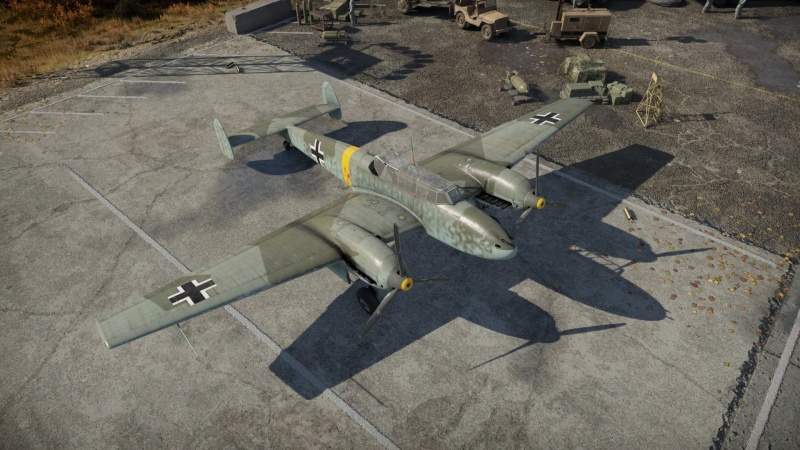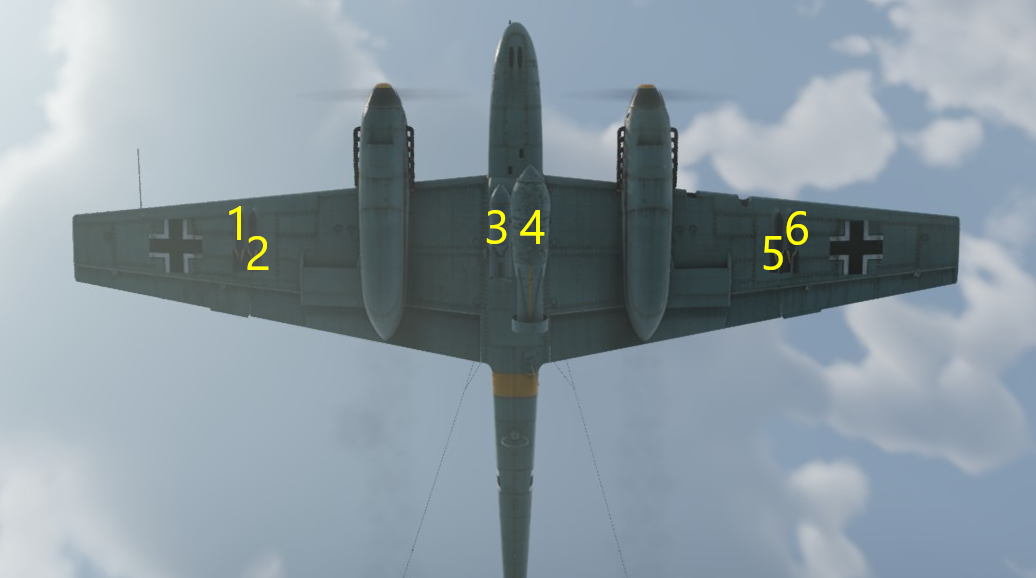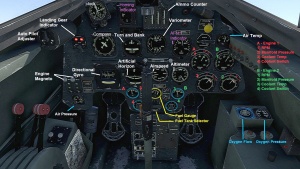Bf 110 C-7
| This page is about the German strike aircraft Bf 110 C-7. For other versions, see Bf 110 (Family). |
Contents
Description
The Bf 110 C-7 was a German heavy fighter, developed in the late 1930s. The development started when RLM issued a request for a new multipurpose fighter with long range and an internal bomb bay. The specifications asked for a twin-engined, all-metal monoplane armed with cannons and bomb bay, as well as having a three-man crew. Henschel, Focke-Wulf, and Bayerische Flugzeugwerke responded to the request. The Bf 110 prototype came out victorious over the other companies' prototypes as it was faster, had longer range, and heavier armament. The Bf 110s served as long-range escort fighters where they saw success during the Polish and French campaigns. However, they were heavily decimated during the Battle of Britain when facing the single-engined Spitfires and Hurricanes. After this debacle, the Bf 110s moved to night fighter roles equipped with radar or as ground attackers. The Bf 110 C was the first major production series, equipped with DB 601 engines, the C-7 was based on the previous C-4/B, made into a fighter-bomber by adding a pair of ETC 500 bomb racks on the centreline and uprated DB601P engines.
It has been in the game since the start of the Open Beta Test prior to Update 1.27. Originally modelled as the Bf 110 C-4, the vehicle was renamed and remodelled into the C-7 in Update 1.79 "Project X". In-game, it is one of the fastest aircraft at its battle rating. It packs incredible firepower with four 7.92 mm MG 17s and two 20 mm cannons, with a copious 360 rounds all in a centreline mount, a hard-hitting package that will reach out and destroy aircraft from afar. Being a pure Boom & Zoom fighter, it is generally recommended to fire both guns when attacking enemies in order to maximize hit probability at close distances when making a high-speed pass.
General info
Flight performance
| Characteristics | Max Speed (km/h at 5,300 m) |
Max altitude (metres) |
Turn time (seconds) |
Rate of climb (metres/second) |
Take-off run (metres) | |||
|---|---|---|---|---|---|---|---|---|
| AB | RB | AB | RB | AB | RB | |||
| Stock | 538 | 523 | 23.0 | 23.7 | 8.1 | 8.1 | 444 | |
| Upgraded | 582 | 560 | 21.1 | 22.0 | 14.4 | 10.9 | ||
Details
| Features | ||||
|---|---|---|---|---|
| Combat flaps | Take-off flaps | Landing flaps | Air brakes | Arrestor gear |
| ✓ | ✓ | ✓ | X | X |
| Limits | ||||||
|---|---|---|---|---|---|---|
| Wings (km/h) | Gear (km/h) | Flaps (km/h) | Max Static G | |||
| Combat | Take-off | Landing | + | - | ||
| 467 | 438 | 290 | ~15 | ~5 | ||
| Optimal velocities (km/h) | |||
|---|---|---|---|
| Ailerons | Rudder | Elevators | Radiator |
| < 360 | < 350 | < 370 | > 715 |
| Compressor (RB/SB) | ||
|---|---|---|
| Setting 1 | ||
| Optimal altitude | 100% Engine power | WEP Engine power |
| 3,800 m | 2,100 hp | 2,243 hp |
Engine performance
| Engine | |||||
|---|---|---|---|---|---|
| Engine Name | Number present | ||||
| Daimler-Benz DB-601A 12-cylinder | 2 | ||||
| Engine characteristics | |||||
| Weight (each) | Type | Cooling | |||
| 590 kg | Inline | Water | |||
| Engine power (Stock) | |||||
| Mode | Max | Take-off | |||
| Arcade | 939 hp | 1,009 hp | |||
| Realistic/Simulator | 929 hp | 999 hp | |||
| Engine power (Upgraded) | |||||
| Mode | Max | Take-off | |||
| Arcade | 1,096 hp | 1,166 hp | |||
| Realistic/Simulator | 1,010 hp | 1,080 hp | |||
| WEP Duration | |||
|---|---|---|---|
| Arcade | Realistic/Simulator | ||
| 25 seconds | Infinite | ||
Survivability and armour
- 5.5 mm steel underneath pilot
- 6 mm steel underneath gunner
- 8.5 mm steel behind offensive 7.92 mm machine gun ammo
- 8.5 mm steel behind frontal 10.5 mm steel plate
- 8.5 mm steel behind pilot
- 8.5 mm steel on the sides of previously mentioned steel plate
- 8.5 mm steel in front of gunner
- 10.5 mm steel behind offensive 7.92 mm machine guns
- 10.5 mm steel behind pilot's head
- 58 mm bulletproof glass in front of pilot
- Self-sealing fuel tanks (2 in each wing)
Modifications and economy
When you first purchase the Bf 110 C-7 make sure you research machine gun and cannon belts first; those are vital for success. Consider the "AP-T" belt for the machine gun and "Stealth" or "Air targets" for the cannon. It is excellent at ground attack as well with guns and bomb selection, but remember that outside of AB, you have no bombing sight.
Armaments
Offensive armament
The Bf 110 C-7 is armed with:
- 2 x 20 mm MG FF/M cannons, chin-mounted (180 rpg = 360 total)
- 4 x 7.92 mm MG 17 machine guns, nose-mounted (1,000 rpg = 4,000 total)
Suspended armament
The Bf 110 C-7 can be outfitted with the following ordnance:
| 1 | 2 | 3 | 4 | ||
|---|---|---|---|---|---|
| 50 kg SC50JA bombs | 2 | 4* | 4 | 2 | |
| 250 kg SC250JA bombs | 1 | 1 | |||
| 500 kg SC500K bombs | 1* | 1 | |||
| 1,000 kg SC1000L2 bombs | 1* | ||||
| Flam C 250 incendiary bombs | 1 | 1 | |||
| Flam C 500 incendiary bombs | 1* | 1 | |||
| * Marked ordnance cannot be carried in conjunction with 1,000 kg bombs on hardpoint 3 | |||||
| Default weapon presets | |
|---|---|
| |
Defensive armament
The Bf 110 C-7 is defended by:
- 1 x 7.92 mm MG 15 machine gun, dorsal turret (750 rpg)
Usage in battles
What the Bf 110 C-7 cannot do is turn fight, and this is where a lot of players make a fatal mistake. Heavy fighters cannot manoeuvre like a single engine fighter, it has an unusually poor roll rate and loses energy fast, and can unexpectedly snap-roll: rudder control is critical. It is a pure "Boom & Zoom" fighter and like others of its ilk, live by 2 rules: "Speed is Life, Altitude is Life Insurance", and "Turn to engage (fire at), not follow". Manoeuvres that retain your energy are key, keep your speed and/or altitude up. The 110 really shines in bomber attack or bomber escort where you will have positional advantage and gun solution first.
When engaging a target only turn to shoot (less than 60-degree turn), the moment you realize you cannot get a firing solution to perform other manoeuvres to keep the advantage. For instance, if your target turns hard, pull up trading airspeed for altitude while watching what your target does. As you slow in climb you can turn tighter (even use flaps briefly) and position yourself for another intercept. If you find yourself under threat, an unloaded extension (slow pushover) can be employed to efficiently gain speed. The Bf 110 can dive very fast to rejoin friendlies if needed. A team with bomber smacking Zerstörers and manoeuvrable fighters will decimate the attacking force in Arcade Battles. If you pick up a tail, just remember to manoeuvre yourself to give your teammate the best chance to taking out your pursuer, and do not count on the gunner.
In tank RB, the Bf 110 C7 is a fantastic multipurpose plane, being able to carry various bombs, allowing it to perform both ground pounding and air superiority fighting. For ground pounding, the most recommended setup is 2 x 500 kg bombs with at least 1.5 second fuse. They are loaded on the fuselage and drop one by one, meaning that with accurate aiming, you can consistently get around 2 enemy targets easily. Dive at a target at no more than 45° (its elevator cannot effectively pitch the plane up in time, resulting in a crash. You must have seen lots of Bf 110s crashing) and gather speed up around 500 km/h (if too fast, cut throttle). Zoom in on the target and when it is twice as big as the mouse cursor, place the target between the cursor and the cockpit, and release the bomb. For the 1 x 250 kg + 1 x 1,000 kg setup, the aiming is similar, but place the target closer to the cursor for the 250 kg, and for the 1,000 kg, closer to the cockpit. Once all bombs are out, zoom climb towards your airfield to gain altitude advantage (the average air spawn altitude seems to be around 1,000 m) and keep and eye on the enemy air spawn. Once an enemy plane spawns, you must decide if it is single engined or twin engined as fast as possible. You can force a head on, as your nose mounted cannons are decently effective at this. If the opponent is single engined, avoid turning too much and remain your speed. If necessary, use your tail gun and put a stray of 7.92 mm bullets into it, but remember to use armoured targets belt to compensate for the small calibre. You can also target ground units, especially lightly armoured SPAA / light tank / SPG.
Enemies worth noting:
Yak-2 KABB: Do not think that the Bf 110 C-7 can confidently outmanoeuvre this plane just because it is twin-engined. The Yak-2 has an amazing turn rate for a heavy fighter, thus the Bf 110 C-7 must avoid turning with it, if not dogfighting with it in general. It bears a pair of ShVAK cannons that can easily damage vital parts like engine or cooling systems. It has green camouflage, greatly resembling an Me 410 but with an H-tail just like the Bf 110.
ZSD63: Though it is hard to identify specific SPAA vehicles on the ground (especially when they are shooting tracers at the plane), if a ZSD63 is identified, avoid it at all costs and do not attempt head-ons with it, ever. It can easily snap a wing off by causally putting a short burst in the Bf 110 C-7's flight path. Don't even get close to it unless it is occupied with another friendly or if the Bf 110 C-7 is equipped with a bomb that it can use. Even ground target belts on your cannons cannot effectively damage it as its hull is overall quite empty, causing your shells to do little to no damage. Some identifying features of the ZSD63 is its rather boxy and tall hull with a geometric turret sitting at the back, slightly similar to a Wirbelwind's. The firing manner is also distinctive: the sound and green tracers are very rapid, much like a buzz saw, but then it will remain silent for half a minute reloading. Note that an experienced ZSD player will hold its fire or shoot in single salvos with long halts between, making it look like that it's reloading.
Manual Engine Control
| MEC elements | ||||||
|---|---|---|---|---|---|---|
| Mixer | Pitch | Radiator | Supercharger | Turbocharger | ||
| Oil | Water | Type | ||||
| Not controllable | Controllable Auto control available |
Controllable Auto control available |
Controllable Auto control available |
Separate | Not controllable 1 gear |
Not controllable |
Pros and cons
Pros:
- Heavy armament consisting of two cannons (MG FF/M) and four machine guns (MG 17s)
- Plenty of ammunition available for the armament, some RB matches you'll finish with over 1,000 rounds of machine gun ammunition left
- Very manoeuvrable for a strike aircraft
- Can carry quite a payload doubling as an attacker or intruder
- 500 kg payload is sufficient to damage and destroy bombing points and other targets
- Exceptionally heavy burst mass for its rank, with large amounts of Minengeschoß rounds
- Can turn quite well at high speeds
- Extremely deadly opponent at head-ons, never let this aircraft get a good deflection at you
- Sturdy airframe allows for surviving ramming attacks or executing one, though it is generally advised as a last resort
- Climbs generally well, though it cannot match single-engined fighters of its tier, excluding biplanes
- Tail gunner is hard to hit from a level flight of both the enemy aircraft and the defending aircraft
Cons:
- Slow acceleration
- Loses speed easily in turning manoeuvres
- Poor energy retention
- MGFF/M cannons have low muzzle velocity and curved trajectory, making them hard to aim
- Big target
- Only a single 7.92 mm machine gun as defensive armament with a limited cone of fire
- Elevator is prone to damage, may shear off when hit by cannon rounds
- Flight performance on one engine is very poor and struggles to maintain flight
History
Named the "Zerstörer" ("Destroyer" in English), a very appropriate name for its mission, to destroy anything that is in front of it. In the early days of World War 2 the Bf 110 did very well in roaming wolfpacks, being superior to the opposition in the skies over Poland and France, but that changed drastically in the Battle of Britain. Mounting bomber losses resulted in the fateful decision to force the 110's to stay very close to bomber formations, losing position and speed advantages over the RAF fighters. Not surprisingly it resulted in a drastic increase in losses. Faced with faster fighters and more manoeuvrable like the Spitfire it was pulled from the front line, only to return in new roles like the "Jabo" fighter bomber and the "Nachtjäger" night fighter. The most successful role of the aircraft was performing night interdiction duties, where its task was to seek out and destroy enemy aircraft, most notably British bombers participating in night raids. In the "Nachtjäger" role, the plane was equipped with FuG 220 and FuG 202 Lichtenstein radar, optionally equipped with a "Schräge Musik" installation consisting of 2 X 20 mm MG FF/M cannons mounted at a 60 degree angle, and a third crew member seated behind the pilot to assist in the duties with spotting targets, as well as performing the duties of a radar operator.
| Archive of the in-game description | |
|---|---|
|
The Messerschmitt Bf 110 was a twin-engine Zerstörer (Destroyer, heavy fighter) used by the Luftwaffe in WWII. Due to poor performance in its intended role, it was quickly relegated to ground attack and night fighter roles. The Bf 110 C was the first truly mass-produced variant of the 110, powered by the DB 601. The Bf 110 C-4 had improved crew protection. The Battle of Britain showed the Bf 110's fatal weakness which was its inability to dogfight with single-engine fighters. Moreover, while having a decent top speed compared to its main adversary, the Hawker Hurricane, the 110 had very poor acceleration. Nevertheless, the 110 was a good long-range escort fighter, as it had no range limitations like the Bf 109 E. Working above the bombers, the 110 could successfully use hit-and-run tactics against attackers; they could dive at the enemy, fire their extremely powerful armament from a distance, and return to a higher altitude. | |
Media
- Skins
- Videos
See also
- Related development
External links
- [Devblog] Messerschmitt Bf 110 model updates, new modifications
- [Wikipedia] Messerschmitt Bf 110
- Official data sheet - more details about the performance
| Germany strike aircraft | |
|---|---|
| Messerschmitt | |
| Bf 110 | Bf 110 C-6 · Bf 110 C-7 · Bf 110 F-2 · Bf 110 G-2 · Bf 110 G-4 |
| Me 410 | Me 410 A-1 · Me 410 A-1/U4 · Me 410 B-1 · Me 410 B-2/U4 · Me 410 B-6/R3 |
| Dornier | |
| Do 335 | Do 335 A-0 · Do 335 A-1 · Do 335 B-2 |
| Focke-Wulf | |
| Fw 190 | Fw 190 F-8 |
| Heinkel | |
| He 219 | He 219 A-7 |
| Henschel | |
| Hs 129 | Hs 129 B-2 · Hs 129 B-2 (Romania) · Hs 129 B-3 |
| Junkers | |
| Ju 87 | Ju 87 G-1 · Ju 87 G-2 |
| Foreign: | |
| USSR | ▀IL-2 (1942) |







